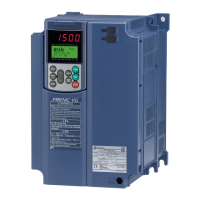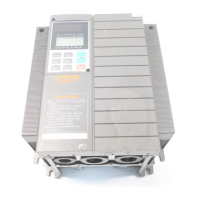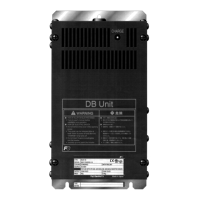7.4 List of Periodic Replacement Parts
7-6
7.4.1 Judgment on service life
The inverter has the life prediction function for some parts which measures the discharging time or counts the
voltage applied time, etc. The function allows you to monitor the current lifetime state on the LED monitor and judge
whether those parts are approaching the end of their service life.
The life prediction function can also issue early warning signals if the life time alarm command LIFE is assigned to
any of the digital output terminals. Refer to Chapter 3 “3.4.5 Reading maintenance information “Maintenance
Information:
%che
””.
Table 7.4-2 lists the parts whose service life can be predicted and details the life prediction function. The predicted
values should be used only as a guide since the actual service life is influenced by the ambient temperature and
other usage environments.
Table 7.4-2 Life Prediction
Object of life
prediction
Prediction function End-of-life criteria
Prediction
timing
“5: MAINTENANCE”
Exceeding 87,600 hours
(10 years)
During ordinary
operation
5_06
(Cumulative run
time)
Cooling fans
Counts the run time of the
cooling fans.
Exceeding 87,600 hours
(10 years)
During ordinary
operation
5_07
(Cumulative run
time)
The service life of the DC link bus capacitor can be judged by the “Measurement of discharging time of the DC link
bus capacitor” or “ON-time counting of DC link bus capacitor.”
Measurement of discharging time of the DC link bus capacitor
• The discharging time of the DC link bus capacitor depends largely on the inverter’s internal load conditions, e.g.
options attached or ON/OFF status of digital I/O signals. If actual load conditions are so different from the ones
at which the initial/reference capacitance is measured that the measurement result falls out of the accuracy level
required, then the inverter does not measure.
When the inverter is connected with a converter or with another inverter via DC common connection, it does not
performs any measurement.
• The capacitance measuring conditions at shipment are drastically restricted, e.g., all input terminals being OFF
in order to stabilize the load and measure the capacitance accurately. Those conditions are, therefore, different
from the actual operating conditions in almost all cases. If the actual operating conditions are the same as those
at shipment, shutting down the inverter power automatically measures the discharging time; however, if they are
different, no automatic measurement is performed. To perform it, put those conditions back to the factory default
ones and shut down the inverter. Refer to 7.4.1 [ 1 ] Measuring the capacitance of DC link bus capacitor in
comparison with initial one at shipment on page 7-7.
• To measure the capacitance of the DC link bus capacitor under ordinary operating conditions when the power is
turned OFF, it is necessary to set up the load conditions for ordinary operation and measure the reference
capacitance (initial setting) when the inverter is introduced. For the reference capacitance setup procedure, see
[ 2 ] on page7-8 Performing the setup procedure automatically detects and saves the measuring conditions of
the DC link bus capacitor.
Setting bit 3 of H98 data at “0” restores the inverter to the measurement in comparison with the initial
capacitance measured at shipment.

